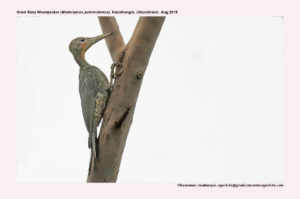
Great Slaty Woodpecker Mulleripicus pulverulentus
Etymology
- Mulleripicus : Named after German ornithologist Salomon Müller (1804–1864); Picus : Latin word for Woodpecker; Greek Mythology Picus, king of Latium, who married the beautiful nymph and songstress Canens and was changed into a woodpecker by the spiteful Circe, whose affections he had spurned
- Pulverulentus : Latin word for “ Dusty, powdered” derived from pulvis – dust
Vernacular name: Cachar: Daoja gadaiya gadeba
Distribution in India: Himalayas and North East India
Description: Size of 45–51 cm; wt. of 360–563 g. It is a very large, the biggest Old World woodpecker, with very long bill, long neck and long tail. The male has pale red cheek patch, creamy to yellow-buff chin and throat, feathers of lower throat are tipped pale red; rest of head and upperparts are slate-grey with variable number of small whitish feather tips. It has small pale spots often most prominent on ear-coverts and hindneck. The wings and tail are darker blackish grey, very narrowly edged and tipped blue-grey. It is slate-grey below, slightly paler than upperparts, small pale streak-like spots on upper breast, becoming paler grey on lower belly; very long, strong bill chisel-tipped, blackish on culmen and tip, yellowish on lower mandible and base of upper mandible. The iris is brown, orbital skin is grey; legs are blue-grey or greenish grey. The female lacks red on cheeks and red tips on lower throat. It is slightly shorter-winged and narrower-billed than male. The juvenile is duller, browner, particularly above, chin and throat are whiter, and generally more spotted below. The juvenile male has red malar larger than on adult, sometimes some red on crown.
Habitat: It is found in semi-open moist deciduous and tropical evergreen forests, adjacent secondary forest, clearings with scattered tall trees; park-like, woodland, Dipterocarp and teak forests. It frequents lowlands and lower hills below 600 m, but also occurs up to 2000 m.
Food Habits: It eats ants; also other insects, such as stingless bees, termites and larvae of wood-boring beetles. Small fruits are eaten at times. It is found usually in pairs, and regularly in noisy family parties of 3–6 birds. It is sometimes associated with other woodpeckers, such as White-bellied Woodpecker when foraging. It forages mainly in tall trees, including solitary ones in open areas; flies long distances to reach these. It sometimes visits smaller trees and saplings at low levels, not infrequently close to ground. It climbs trunks and larger branches slowly, pausing frequently at crevices and other depressions and cracks in bark; may perch crosswise in crown, even on small branches. Gleaning is the most frequent technique used, and the long neck and bill assist it in reaching a long way out. Other foraging techniques include probing, pecking, prying-off of bark; also hammering with powerful loud blows to excavate wood and attempting to catch flying insects. In foraging groups, females principally climb and search. The males will be hammering, pecking and flaking, and grouping is speculated to be induced by cooperatively searching for and exploiting infrequent but highly profitable food sources. It does not remain long at one spot to peck or hammer. It is relatively nimble when foraging among branches, but climbs almost in “slow motion”.
Breeding Habits: They breed in Mar–May in West, Mar–Aug in South East Asia; Jun–Aug and Dec–Feb on Borneo. The displays include strange-looking head-swinging, head appearing to lag behind body in its swinging movement; during chases, wings extended widely, tail is also spread. The nest-hole is excavated by both sexes, although male does most of the work, in large trunk or branch, entrance hole. The old nest occasionally is reused, probably only when new one usurped, and sometimes adopts or adapts cavity previously used by another hole-nester, like a Dollarbird or Brown Boobook. They lay a clutch of 2–4 white eggs. Both sexes incubate.